 |
Please note : There are lots of large pictures on this page
that may take some time to download if using a dial up connection.
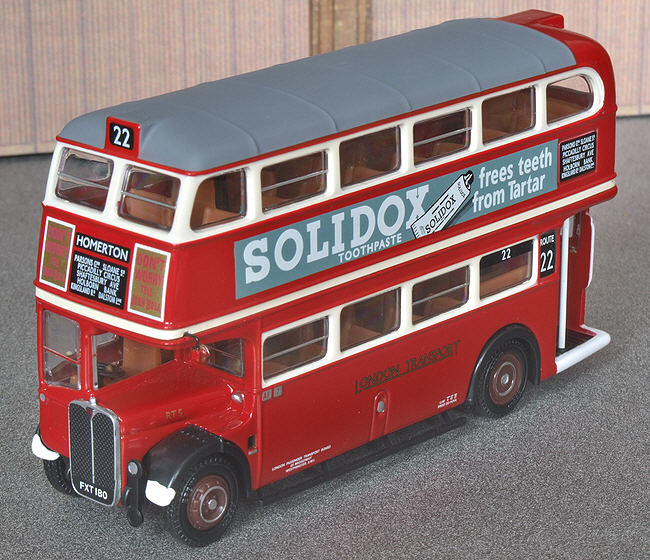
34001 RT5 the 2RT2 AEC Regent
|
A Brief History
The Pre-war 2RT2
The pre-war RT is a term used to describe the first 151 examples of a class that would ultimately number almost 7000 vehicles. In actual fact only prototype RT1 is a true pre-war vehicle, the first of the production buses didn't enter London Transport service until the 2nd January 1940 some four months after the start of world war II. The first 150 production vehicles were ordered in July 1938 just three months after prototype RT1 had been completed. RT2-151 all had chassis built at AEC's Southall factory and carried LPTB 56 seat bodies built at the board's Chiswick Works. This batch of vehicles were commonly dubbed RT2s by staff during their careers in the capital.
The first vehicles were allocated to Chelverton Road Garage in Putney (AF) and used on routes 22, 28, 30, 37 & 72. Their use on route 22 was however unofficial and its operation was transferred to the newly opened Gillingham Street Victoria depot (GM) on the 20th March 1940. Putney Bridge (F) was the second garage to receive the RTs and the vehicles took up duties on routes 14, 74, 85, 93 & 96. Due to war time shortages body production was slow and the final member of the initial batch of 150 buses RT151 wasn't completed until early 1942, this vehicle was allocated to Gillingham Street who by that time had taken over the operation of route 72 and inherited its RT allocation.
The RT2s proved popular and after a few teething problems with the braking system were resolved settled down to service on the capitals streets, although a further batch 338 examples had been ordered in November 1938 these were never built due to the growing affects of the war and it would be over 5 years before further new RT class vehicles entered service.
The non-standard nature of the RT2s made their life relatively short when compared to their post war cousins and the entire class was withdrawn from public service between February and May 1955.
Most of the withdrawn buses were converted for use as driver trainers or staff buses and seven examples gained a late reprieve due to a weak bridge. These were re-painted green before being sent to Hertford garage where they took over from STLs on route 327 on the 1st June 1955. The vehicles remained on the this route and made appearances on some of the depots other routes until end of August 1957 after which they joined their sisters on staff and training duties.
17 surplus vehicles had been sold in December 1955 while another RT106 became 1036TV and was used as a tip over vehicle for trainee recovery gangs. Surplus RTLs began to replace the RT2s on training and staff bus duties in 1959 and during 1960 a large number of RT2s were sold and mainly went for scrap. The final RT2s were retired by London Transport and sold in 1963.
Four RT2s RT8, 44, 54 & 113 are known to have survived into preservation in the UK.
A more detailed history of the 2RT2 vehicles complete with individual vehicle histories can be found the excellent Ian's Bus Stop website.
|
|
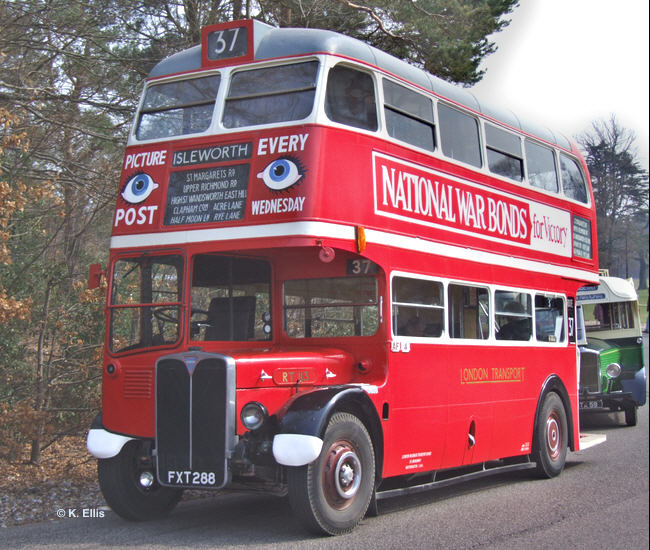
Preserved RT113 at the Cobham Bus & Coach Gathering in 2007
|
| The Model
The model depicts RT5 in its as delivered livery with off-white window surrounds and a silver grey roof. RT5 was among the first batch of vehicles to enter service from Putney's Chelverton Road Depot in January 1940 and due to the war time blackout restrictions had a masked headlamp and white markings on the front mudguards, platform and rear. The vehicle was also originally fitted with an under canopy route number stencil holder but the use of these was short lived due to the blackout.
|
|
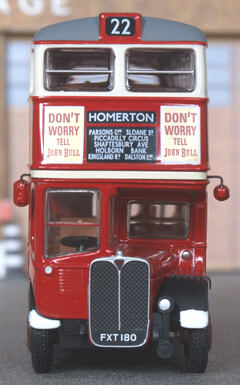 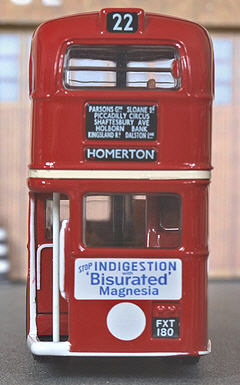
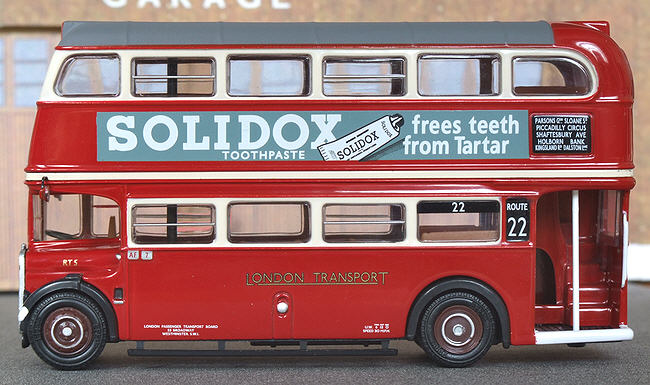
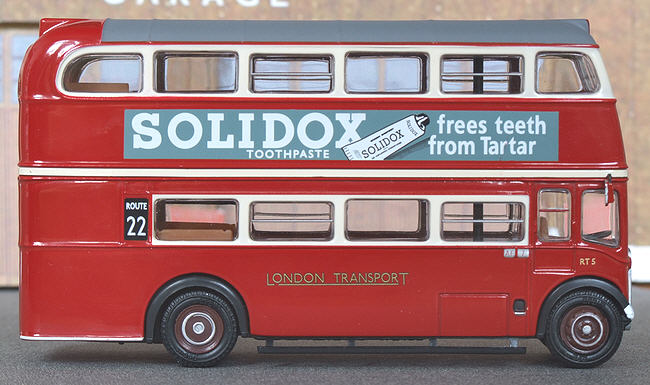
|
|
First impressions of the model suggest it looks right. The characteristic curved drivers windscreen and off-side window have been captured well as has the slight slope to the bottom edge of the drivers near side window.
This particular release only has a singe headlamp on the near side, this is highlighted with a spot of silver paint suggesting what would have been an illegal un-masked lamp! It's also notable that the same plastic component includes an unpainted spotlight beneath this, something that wasn't fitted to the vehicles until the off-side low mounted headlamp, which isn't depicted at all, was reposition into the panel beneath the driver's windscreen some years later.
The model has mirrors which are fitted in a similar style to those on the re-tooled Routemasters, thankfully these appear much more to scale and don't protrude to the same degree.
Internally the familiar EFE poles are used to hold the model together. The seating units are single piece light brown plastic components as per the original RT although the drivers steering wheel now appears to be a separate component and has an authentic black finish. The lower deck ceiling is finished in cream but unlike the recent RLH is devoid of any additional detailing.
The platform grab pole does appear somewhat heavy especially when compared to the thinner grab rails present on the platform bulkhead and rear panel, like the RLH the platform pole would be improved if the white area didn't extended over its full length.
Two nice improvements are the addition of a proper recess under the staircase and a proper platform bulkhead which like the Routemasters & RLH is a painted plastic insert that has a grab rail and used ticket box detail moulded in to it.
|
|
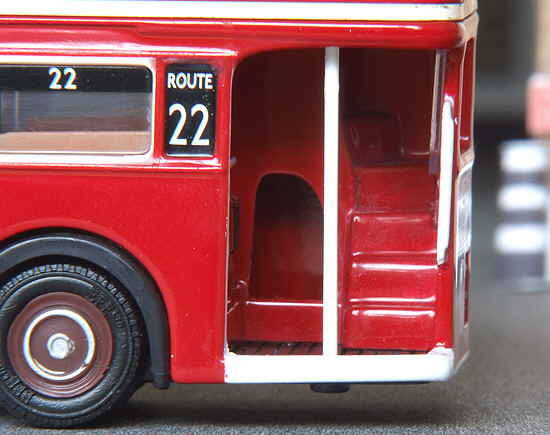
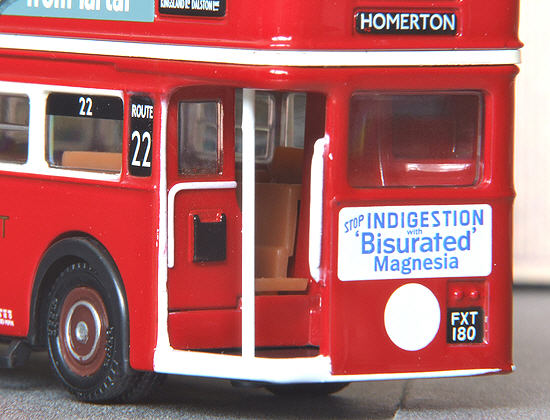
|
|
The base at first glance appears to be unaltered but on closer inspection it becomes clear that the front mudguards have been refined and most notably very slightly reduced in width so they no longer over extend the bodywork.
|
|
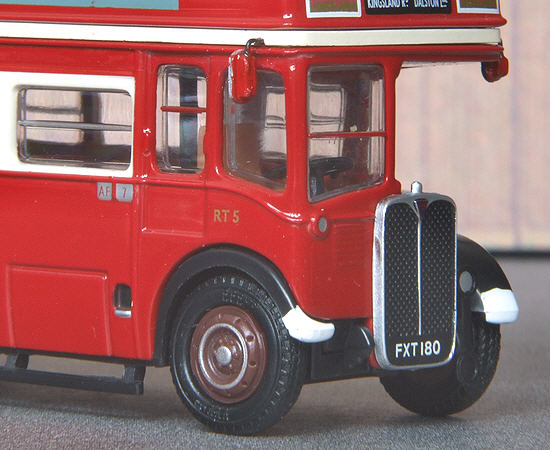
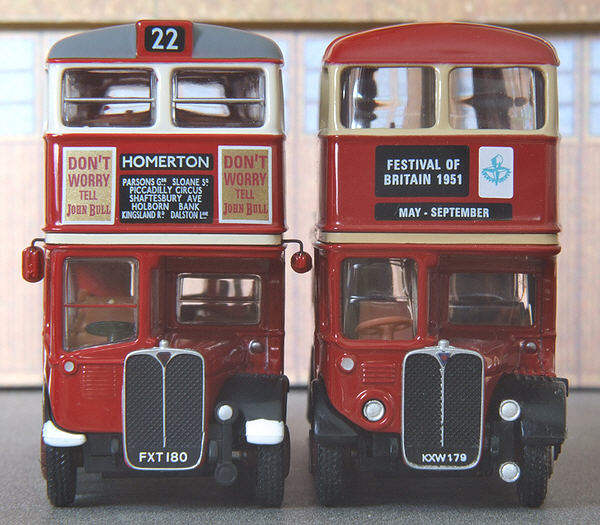
The front mudguards are now slightly narrower and are more accurate as a result when compared with the original RT
|
|
The tampo printing is well up to EFE's normal standards and includes the now familiar nicely scaled black outlined gold fleet names. The same Solidox Toothpaste advertisements appears on both sides of the model while red on gold John Bull advertisements are positioned either side of the front destination. A lower rear Bisurated Magnesia advertisement completes the period advertising and these like the fleet names are all very neatly reproduced.
Tiny but fully legible London Passenger Transport Board legal lettering and weight details appear on the lower near side panels.
Silver garage code plates showing AF 7 are carried in the correct positions on each side of the bus while on the front a tiny AEC badge has been reproduced on the radiator along with the registration number.
The near side bonnet fleet number is applied to a raised area to depict the cast bonnet plate fitted to the RTs.
The two sidelights are picked out with silver paint on the front as is the near side fuel filler cap. The tail lights above the rear number plate are cast but have been left in the main red body colour.
|
|
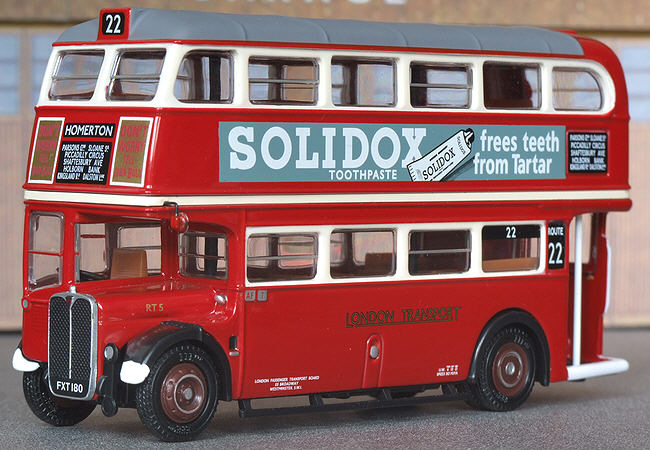
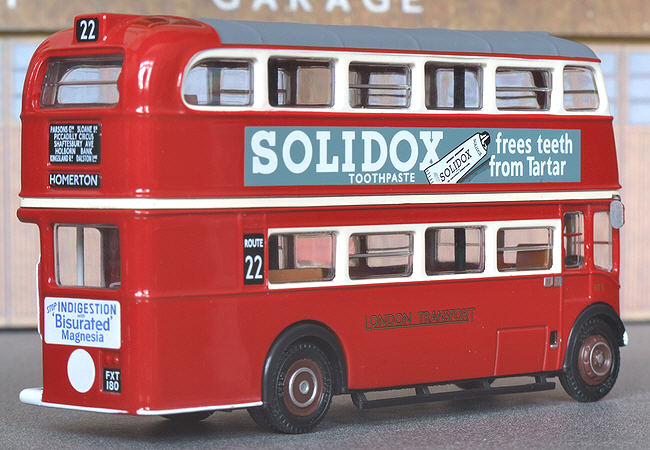
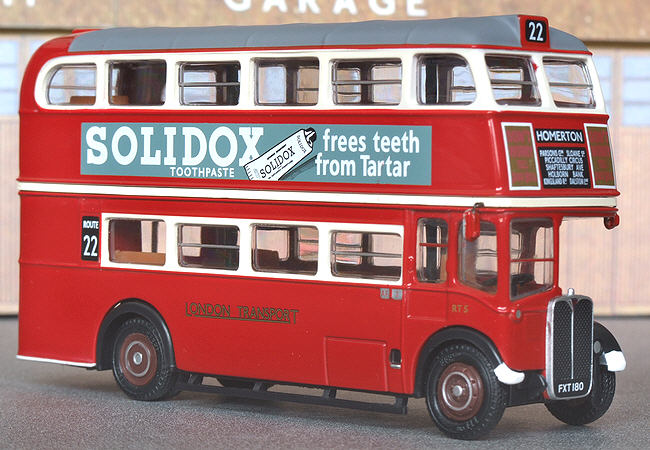
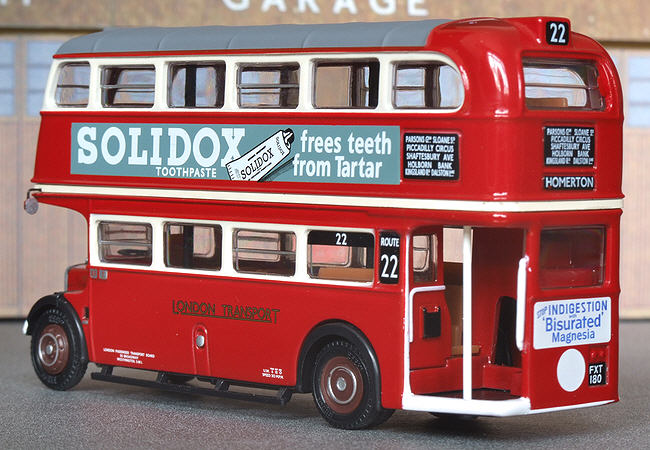
|
|
A full set of blinds for route 22 are fitted, the upper deck casting has roof number blind boxes front and rear while the main front, rear and side blinds contain capitalized main terminal and smaller via points in the correct style and layout. The near side and rear blind box outlines are moulded into the upper deck casting but this extra detailing hasn't been repeated on the front.
|
|
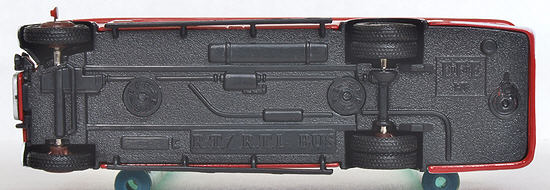
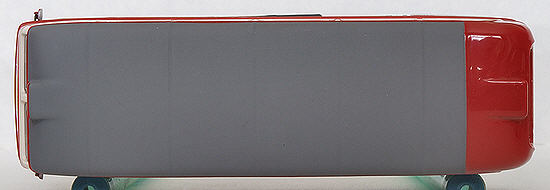
|
|
Flusher glazing is now fitted to the model and this includes moulded window vents which have been neatly highlighted with either red or silver paint as appropriate.
There aren't many major problems with the model to my eyes but nit picking its notable that the upper deck front and side windows appear to have become slightly shallower during the re-tooling process.
The curve on the lower edge of the front off-side panel below the drivers windscreen doesn't look quite right and the off-side rear panels don't depict the notable inward curve of the lower side panels which should match the same profile found below the side windows. This was characteristic unique to the LBPT built body fitted to the RT2s so its omission is a little disappointing. Finally after the RLH with its full panel beading the lack of any such detail on this model leaves the sides in particular looking rather under detailed in my opinion.
All in all this isn't a bad model, its not 100% perfect granted but it still manages to captures the essence of these early members of the RT class and will no doubt be welcomed by collectors with London interests.
|
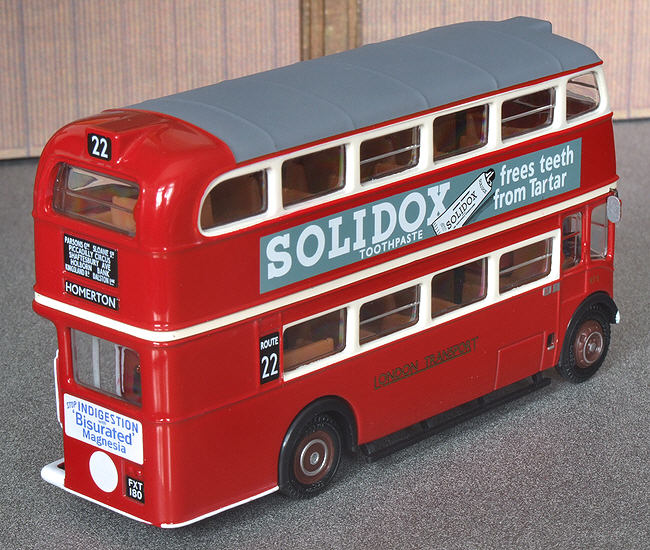
|
| Model Review Index |
|

















